Welcome to part two of our Weserradweg story. We ended part 1 leaving Petershagen after a very soggy arrival the day before. Day 6 of our tour began with dry clothes, shoes, and weather.
The section of the bike route from Petershagen to Cuxhaven is described as Flachland – flatland. It was farmland as far as the eye could see. Nienburg, our target for the day, was 59 kilometers away. There’s not much to say about the ride to Nienburg except to say it is in Germany’s breadbasket.
Nienburg itself was a nice little town. It lies on the German Timber Frame Road, and as you would imagine, it has plenty of good examples of timber-framed buildings. It was founded a long, long time ago (at least 1025), at a convenient crossing point on the Weser.
Our accommodation in Nienburg was fantastic. Hotel Wesserschlössen lies directly on the river. It is an extensive property with a restaurant, a terrace that overlooks the river, and a sauna/wellness center, although it was closed. It dates back to 1844 when a senator wanted to build a summer farm for residents and visitors. Back then it was called “Weserpavilion” but then WW1 happened, and French terms fell out of favor. After the planned rebuilding, they renamed it to Weserschlössen.
After thoroughly exploring the town, we had dinner on the terrace and it was a great idea. The food, the service, and the ambiance were all fantastic. It was the culinary highlight of a trip of otherwise merely adequate meals and made for a perfect ending to the day.
After a good night’s sleep, we went to the restaurant for breakfast, but it was full. Rather than sit in the adjacent conference room, at a table for 15, we opted to have breakfast on the terrace. We soon had a lesson on the differences between the states regarding coronavirus regulations. When the waiter arrived, he advised us that breakfast service is slower than normal and he will bring it to the table. When Kathrin mentioned that we had a buffet breakfast in other hotels on our trip, he reminded us that that was in another state. Lower Saxony doesn’t allow buffets. Over the course of a 530km route, it isn’t very hard to bike through several states.
Once we had checked out of the hotel, we set our sights on our next target – Verden, 66 km down the road. Our standard plan for lunch was to stop at a grocery store along the way and buy some things for a picnic. At about mid-morning we found ourselves in a small town/village and decided it was time to do our shopping – easier said than done. We found no signs of commercial development. Eventually we asked someone where we would find a supermarket. He gave a long description of the how to get the nearest store. We rode away asking each other, “Did you get everything he said?” “Uh, right, right, left…we’ll figure it out.” After a few turns, it looked to us like we were riding out of town. So we stopped and asked two ladies for directions. Turns out we just missed one turn. After a few minutes we were there. This was a learning point for us…the first thing to do after leaving our hotels is to find a grocery store!
Similar to yesterday, we biked through several kilometers of farmland. However, today offered some interesting sights. Shortly after entering the town of Drakenburg, we came across an impressive archway. We looked for an information sign but found none. It was only while writing this post that I learned that the building was part of a castle dating back to the 14th century. The building complex was destroyed in 1627, during the Thirty Years War, and later only the east wing was rebuilt. The walls of the cellar are the only remnants of the original building.
The archway is the historical castle portal and dates from the Renaissance period.
Turns out this town has a violent past. According to Wikipedia, ” The Battle of Drakenburg took place on 23 May 1547 between the Protestant army of the Schmalkaldic League and the imperial troops of Eric II, Duke of Brunswick-Lüneburg, Prince of Calenberg. It resulted in an imperial defeat. Eric had to swim over the Weser River to save his own life. As a result, the imperialists left northern Germany, contributing to freedom of religion for Lutherans and Catholics in northern Germany.”
Shortly after riding out of Drakenburg, we came across another village where we had a stork sighting. Storks are an endangered species, and this area is famous for its Stork population. It was a pleasant encounter and well worth a few pictures.
It was a short, uneventful ride from there to Verden, our stop for the day. Verden has had some unflattering publicity within Germany as one of the hard-hit areas for COVID-19. Fortunately for us, the infection rate had slowed down a few days before our arrival to where we were not so nervous about staying there.
Verden is an ancient town that was founded centuries ago on the Aller River, where tradesmen and travelers would meet to exchange their wares and news. We followed a geocache that offered a tour around the historical city center. It is a quiet, small place that, other than the city hall and surrounding buildings, left us a bit underwhelmed.
Our stomachs started rumbling at 5:30 which reminded us it was dinnertime. After a 20 minute search, we had two choices – an Italian restaurant on the main street, or an Italian place 2 blocks down the same street. Everything else was closed or full. Neither one stood out from the other, so we flipped a coin. This random choice turned out to be a decent one, we were satisfied.
On Sunday morning we left Verden on our way to Bremen, 55km away. Unlike the past two days of biking through farmland, today was an architectural day. While searching for a geocache, we discovered Schloß Etelsen (right) tucked away in a park. It was built in the 1880s in Langwedel.
Around lunchtime, we discovered Schloß Erbhof (below) in Thedinghausen. It was built in 1620 by the Archbishop of Bremen for his mistress, the young widow of the previous Archbishop. The restaurant within the castle grounds, appropriately named “Romance”, looked so inviting that we saved our picnic lunch for another day.

By early afternoon we arrived in Bremen, or more correctly, the Free and Hanseatic city of Bremen. It is the 6th Hanseatic city we have visited and was as impressive as the others. Hanseatic cities are trading cities, and this was obvious while riding through the harbor. The unusual thing about Bremen is that it is 70km from the North Sea Coast.
From the harbor we wandered through town until we came to the historical city center. It was an impressive sight. The Town Hall, the cathedral, the market square all display the former glory of Bremen’s successful trading past.
We decided to stop here for a coffee break before exploring more of the city. The row of restaurants behind the statue in the picture to the right reminded me that Bremen is the home of Beck’s beer. The names of the restaurants are “Becks Bistro” and “Becks am Markt”.
The statue is called The Bremen Roland and was erected in 1404. Roland was a paladin (one of the twelve Companions of the court of Emperor Charlemagne) and hero of the Battle of Roncevaux Pass. He is shown as protector of the city with his legendary sword unsheathed, and his shield with the two-headed Imperial eagle.
Statues of Roland appear in other cities of the former Holy Roman Empire, but this one is the oldest surviving example. UNESCO added the statue, along with the town hall, to the list of World Heritage Sites.
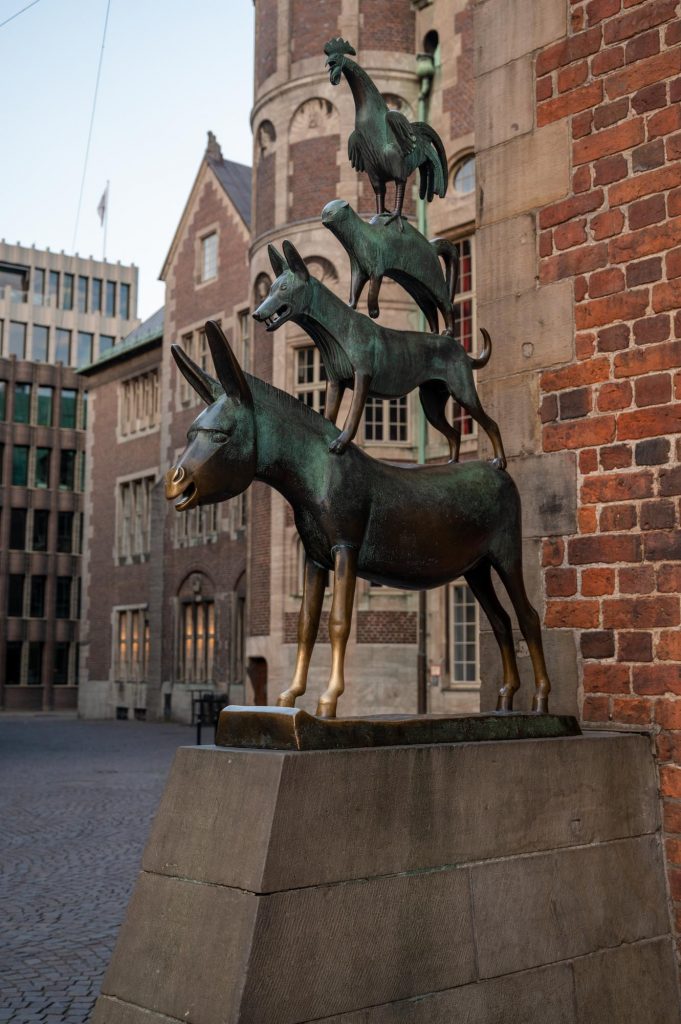
A visit to Bremen is not complete until you visit the Town Musicians of Bremen, or, as the locals call it, Bremer Stadtmusikanten. It is a memorial to one of the Grimm Brothers’ fairy tales and is, along with the town hall and Roland statue, one of the symbols of the city. The fairy tale tells the story of four aging domestic animals, who, after a lifetime of hard work are neglected and mistreated by their former masters. Eventually, they run away and become town musicians in the city of Bremen. The fable has a happy ending that’s worth the few minutes to read (just click on the link at the beginning of the paragraph.)
We stayed at the H+ Hotel right in the city center and were both impressed. The staff was friendly; the well-decorated hotel displayed details and accents that depict the history and style of the city. It did not have the feel of a chain hotel.
We set off for Bremerhaven the following morning. It is at least 1000 years younger than Bremen but is one of Germany’s most important ports. It lacks Bremen’s Hanseatic history and charm but was impressive for its size as a port.
This leg of the journey was our longest, 92km (57 miles.). The route was rather boring once we got out of Bremen, just miles of a quiet paved bike lane. It went along a fenced earthen dike with sheep grazing in the grass.
We knew this leg was going to be a challenge for our batteries. We calculated a little over 82 km, which was within the theoretical range of our bikes, but what will the real-world performance prove to be? We were going to find out. Now here we were, pushing our e-bikes to the limit and riding against the wind. Not the kind of conditions that lifted our spirits. At kilometer 82 Kathrin became anxious. Her planning had been impeccable (as it always is) but yet we have not reached Bremerhaven. What we had not expected was a bridge closure. The detour added an extra 10 kilometers to our journey. We knew where we had to go, so we just kept on pedaling, using as little battery power as possible.

On a lighter note, while on this leg that we saw a common architectural style. More and more houses had thatched roofs. I had the feeling of riding through a hobbit village.
As we approached the outskirts of the city, we came across a dock that our maps suggested would have a ferry. Our dangerously low batteries convinced us to try it. I asked someone official-looking if a ferry did, in fact, stop here. He gave me an answer I interpreted as yes. It departs every 20 minutes and travels 7 km to the city.
After waiting for 30 minutes, we realized something was amiss. Kathrin asked someone about the ferry and they said it is 7km away and departs every 20 minutes. Yikes, the day is getting late, our batteries are getting low, and we really want to make this ferry. So back on our bikes and keep on pedaling. We made it to the real dock 5 minutes after the ferry left. We had to wait 40 minutes for the next one as the 20-minute schedule ended with the ferry that just departed. The evening schedule isn’t as frequent. This did nothing to boost our mood, dampened already by our dwindling battery supply. Still, we had nothing to do but wait for the next one. At least we knew we would be on it.
The ferry departed Blexen, on the west side of the river on schedule and made the 3.1 km trip northwest to Bremerhaven on the east side of the mouth of the river. We departed the ferry much more relaxed about reaching our destination. I had the address of the hotel in my bike’s navigation computer and we had only a few kilometers to ride. Once it declared that we had arrived we were staring at a construction site. Hmmm, we rode to one side of the site, then to the other. We rode around a corner. Still, we didn’t see our hotel. Finally, we rode further than what the computer indicated and we found it. What a relief!
After dropping our bags in the room and freshening up a bit, we biked a few short blocks into the downtown area for dinner. A Moroccan restaurant looked inviting, so we stopped there. It was an interesting dinner. The waiter was very enthusiastic about his job and displayed a bit of showmanship in his tasks. There was a small group of Arabic speaking men, spread across 4 tables, who were engaged in a very passionate conversation/debate.
Once our food arrived, we lost interest in them and enjoyed our Tajine dishes, which reminded us of our Moroccan vacation.
Having finished our meal, the waiter came to take our dishes and then again to deliver the bill. After we had paid, he looked at Kathrin and said “Dankeschön”, then he looked at me and with a smile said “Dankuwel”, which is dutch. It wasn’t the first time someone has mistaken my accent for dutch.
Finally, at 8pm, we returned to our room and fell into our bed for some well-earned rest.
The next day we found our way back to the riverfront where the Weserradweg runs. We met the bike route at this harbor. This seems to be a very active area, there are several museums, a theater, a cinema, shopping centers, and a U-boat-turned-museum. One could spend a lot of time here. I was particularly interested in the U-boat but unfortunately, it was closed. I guess we will have to come back one day and spend more time in this area.

At one end of the harbor area was a monument to German emigrants. For those germans that were looking for a chance to find a better life in another country, Bremerhaven was a major departure point. The monument shows the father pointing to the new life ahead, while the mom looks back at the life they are leaving. It was a thoughtful sculpture.

We rode out of Bremerhaven via its harbor terminal, the entry/exit point for all the shipping activity. It was Sunday so there was no activity going on, but I can imagine that it is a busy area during the workdays.
Our final leg now lay before us. The landscape turned into a quiet rural coastal seaside. Then we entered the vacation area of the coast. At one point we saw a beach vacation spot with a large recreation area with an even larger caravan/RV parking area. It reminded me of a country song about a “Redneck Riviera”. Regardless, we chose this spot to have lunch. There were plenty of benches to sit on and we learned not to take that for granted! Throughout lunch, we agreed that a Redneck Riviera is not the vacation we aim for.
A few hours later we were in Cuxhaven-Duhnen, which is the beach vacation area of Cuxhaven. It is a typical beach vacation area, and the tourists were in force here. There were plenty of cafés, restaurants, souvenir shops, and bars.
The Kugelbake, seen in the image’s background at left, is the symbol of Cuxhaven and once served as a lighthouse. More interesting to us was the sign painted on the path officially marking the end of the Weserradweg. We were excited to have completed what was our longest bike trip to date! The rest of the day we spent enjoying the beach and finding some geocaches.
The next day we explored the city of Cuxhaven. We followed a geocache tour through the fisherman’s wharf and surrounding area where we learned about the city’s history as a fishing town. Unfortunately, the fishing industry has died here. Another geocache tour introduced us to Schloss Ritzebüttel. It was the residence of the Hamburg bailiffs during the time when Ritzebüttel belonged to Hamburg. The castle, some of which dates back to the 14th century, is one of the oldest preserved secular buildings of the North German Brick Gothic style in the region.
With the tour of Cuxhaven over, at 12pm we boarded our train for Hamburg to visit friends for two days before returning home.
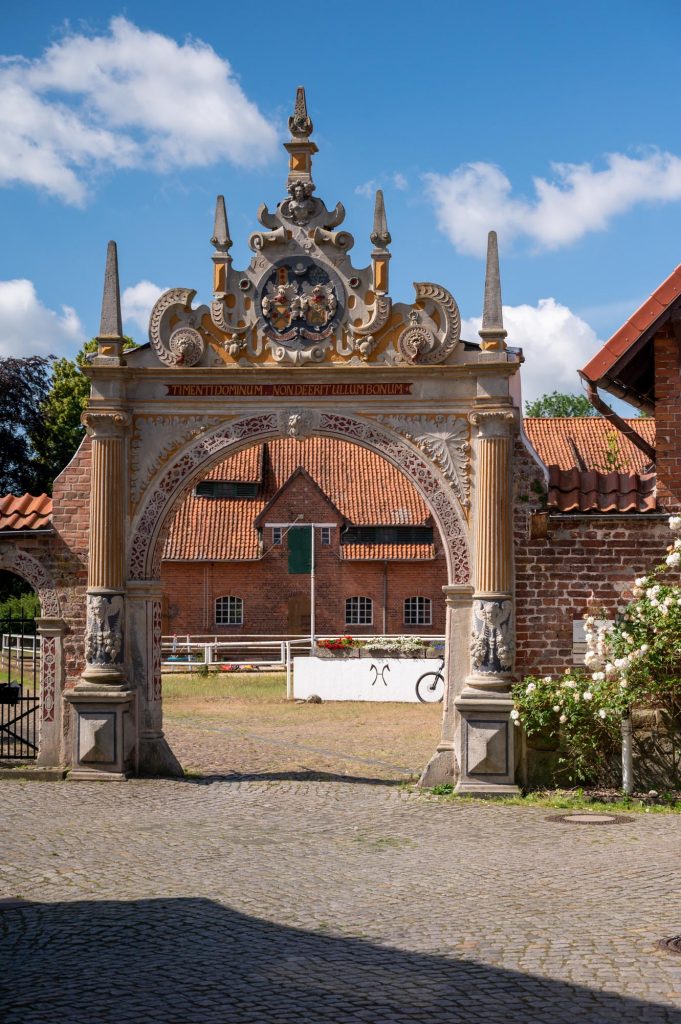

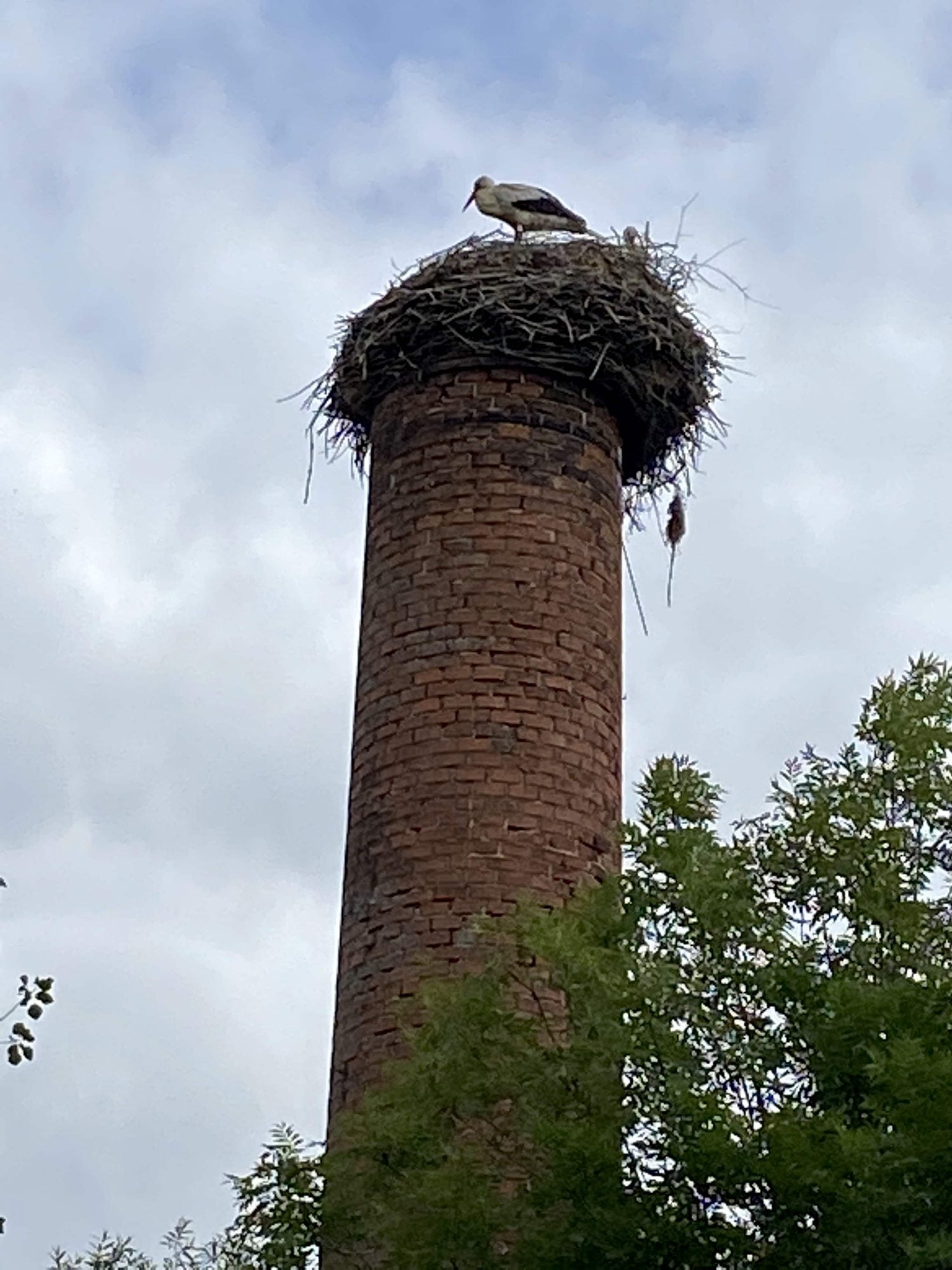
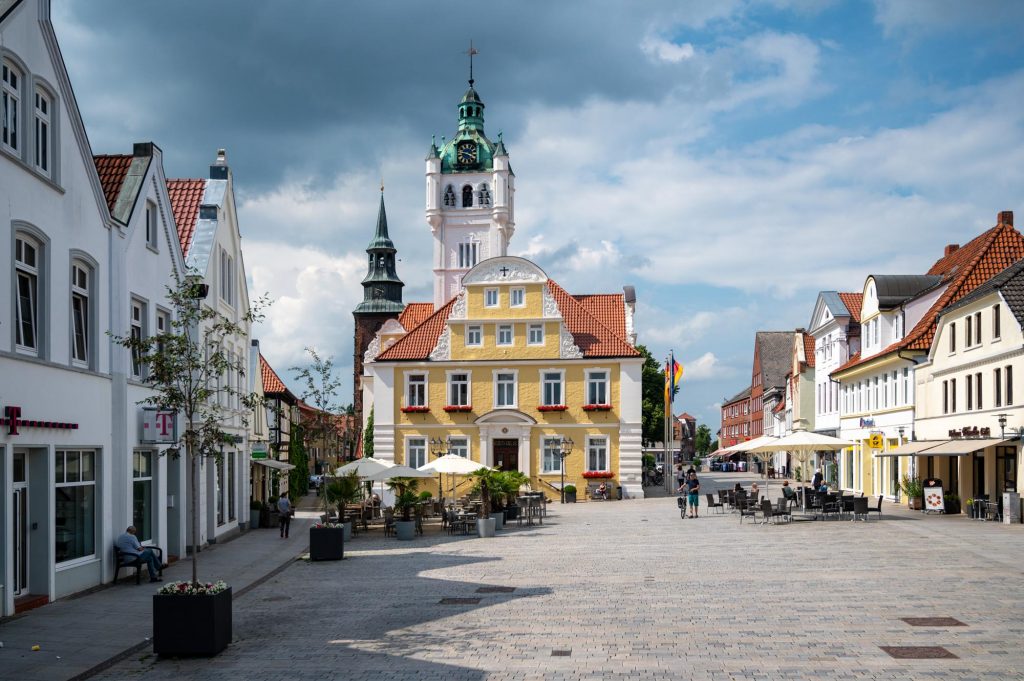




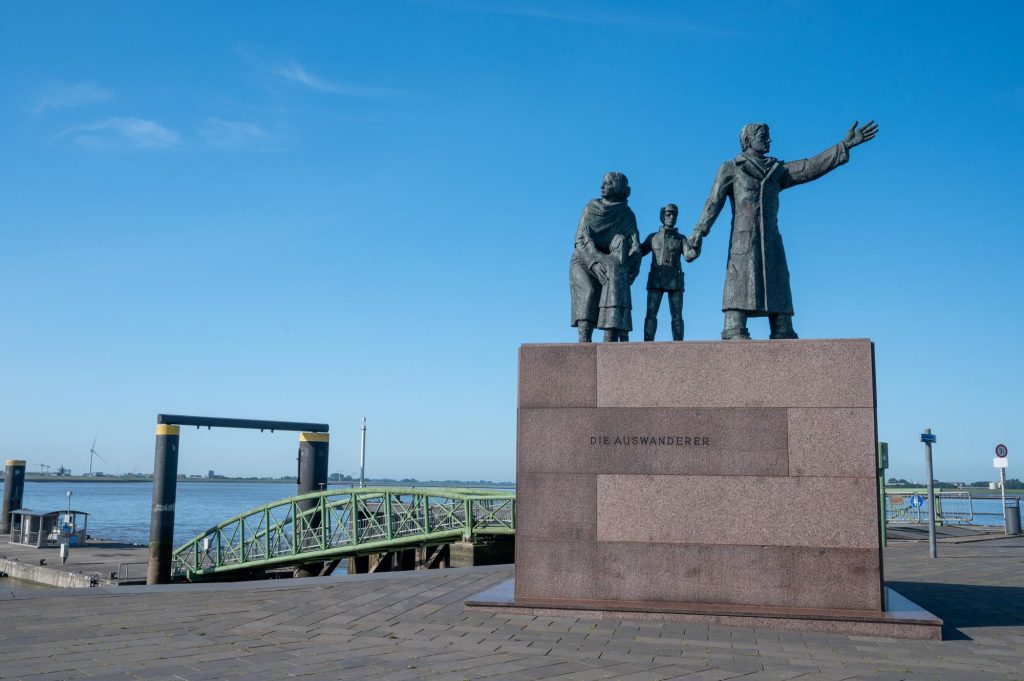
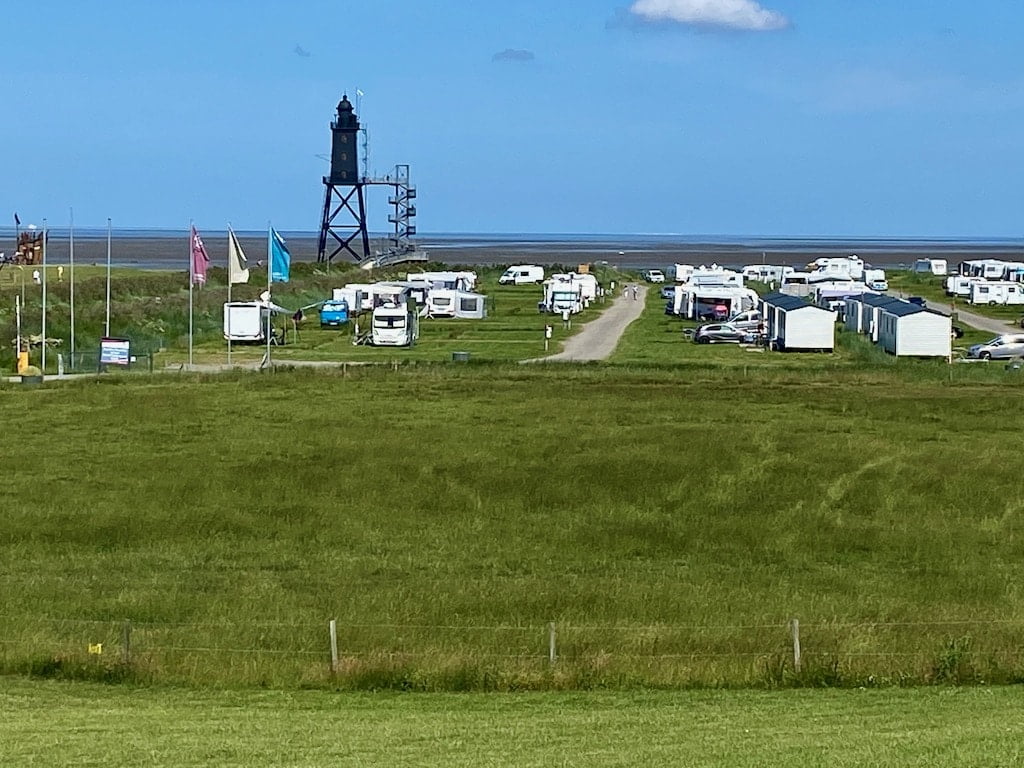
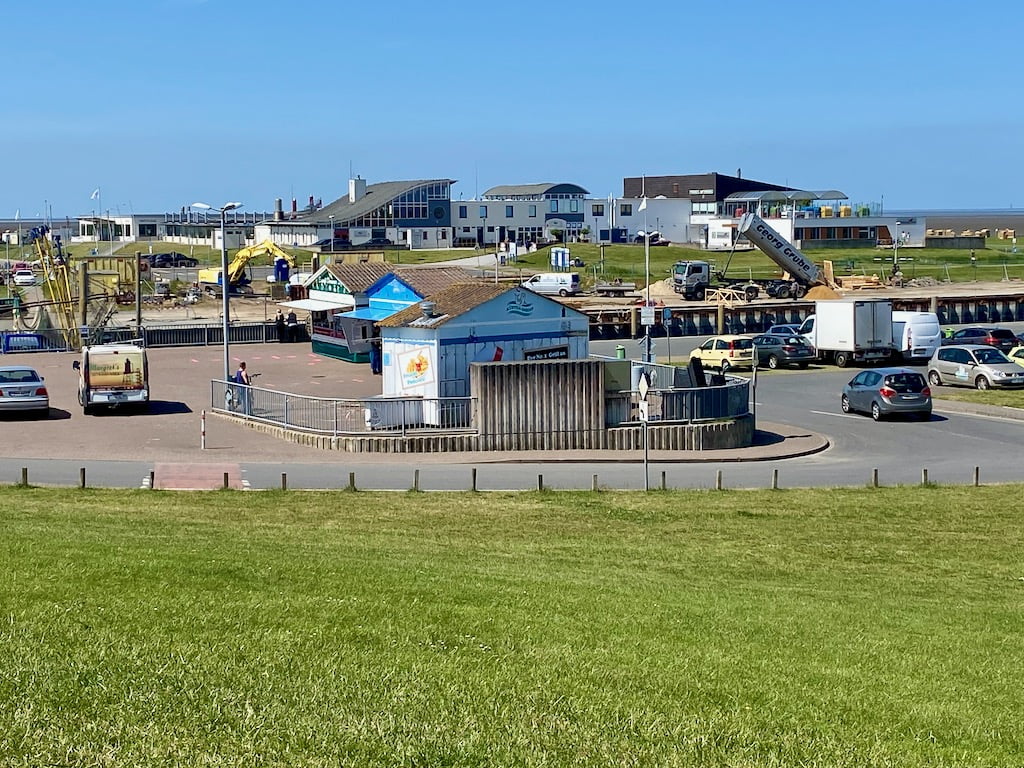
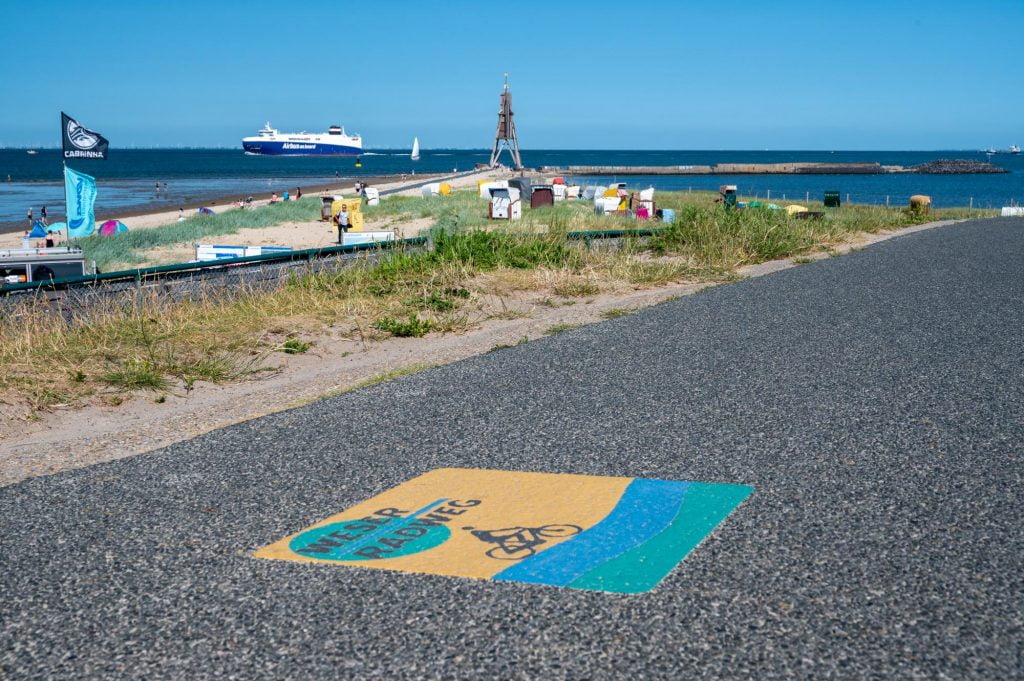

Leave a Reply